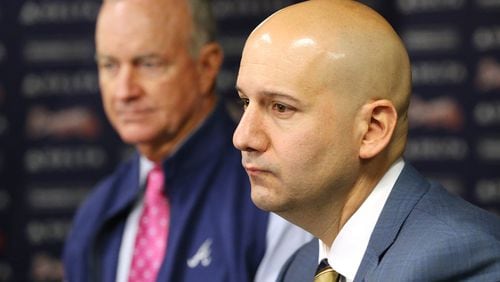John Hart became the Braves’ caretaker on Sept. 22, 2014, the day Frank Wren was “terminated” as general manager. Two years and 11 days later, Hart – the officially titled president of baseball operations – sat in the same room at Turner Field and cast a backward glance. “If you’d asked me to sign in blood two years ago to be where we are now,” he said, “I would have done it.”
The great rebuild is not yet, or even nearly, complete. The Braves lack a real catcher. They hope to sign two starting pitchers via free agency. Not everything they’ve tried – and they’ve tried pretty much everything – has worked, but enough has that they’ve cobbled together a competitive big-league lineup and a bullpen of some promise, that they’ve gone from having one of the five worst farm systems to owning the best.
They’re probably another year from actual contention, but the combination of a winning second half of this MLB season and the playoff success of their top three affiliates has served to lift every heart in this proud organization. Things are starting to happen – good things, big things – and they’re happening sooner than anyone would have guessed.
Said Hart: “We have a full system now. The major-league club had a good second half. We have a new ballpark. This has all happened in short order. Instead of this being a five-year thing, we’re thinking it’s going to be quicker.”
For such tear-down-to-build-up projects, no timetable exists. Under former Braves exec Dayton Moore, the Royals needed seven full seasons to make the playoffs. Theo Epstein’s Cubs didn’t nose above .500 until Year 4. Jeff Luhnow inherited the 106-loss Astros and saw them lose 107, 111 and 92 games in his first three years before grabbing a wild card last season.
Moore’s Royals had six top 10 draft picks in seven years. Epstein’s Cubs had four in four. Luhnow’s Astros had five in four. What makes the Braves’ reset so astonishing is that general manager John Coppolella, having exercised only one top 10 pick, has created workarounds, most notable the purloining of Dansby Swanson, the overall No. 1 in 2015, from Arizona.
“I’ve been through these before, with Cleveland and Texas,” Hart said. “I’ve watched Houston and the Cubs and Pirates and Kansas City. The most valuable asset I’ve been fortunate to have is John Coppolella, with his work ethic and creativity.”
Rebuilds come with only one guarantee: They’ll feel awful before they begin to feel good, assuming they ever do. “This is painful,” Hart said. “This is tough. But we’ve never wavered.”
The Braves’ first big selloff was Jason Heyward. Then Justin Upton, then Evan Gattis, then Craig Kimbrel and Melvin Upton Jr., then Alex Wood, then Andrelton Simmons, then Shelby Miller. The total WAR (wins above replacement) value for those eight this season was 12.2, per Baseball-Reference. Their total salaries came to $78.366 million. The 2016 Braves received a collective WAR of 15.2 from Freddie Freeman, Julio Teheran and Ender Inciarte – for $15.830 million.
With his economics degree from Notre Dame, Coppolella is deft at cutting cost. With his background in the Braves’ scouting department, he also knows which talents are expendable and which aren’t. Some believed he erred by not trading Freeman and Teheran along with the others, but in Freeman, the Braves have their cornerstone, and in Teheran, their No. 1 starter. How hard would it be to find such commodities on the open market, and at what cost?
Ultimately the Braves’ plan will rise or fall on their lovingly assembled young talent, and youth is both tantalizing and terrifying: What if none of these guys pans out? That’s why the only prudent approach involves volume. Even if one or two or five of the kids flop, there’s not much chance they all will – not if you have the right guys scouting and developing them. As Hart said: “It takes a village. You have to put the right people in place.”
Which is why it was a big deal, in the first weeks after Wren’s ouster, to promote Brian Bridges to scouting director and bring back Roy Clark, who’d left for the Nationals. Coppolella’s vision includes “wave after wave of prospects” coming through the system: “I believe in waves,” he says, “not windows.” And Swanson, the tip of Wave 1, was as good as advertised.
Let’s be clear. The Braves aren’t yet where they need to be. But, as Hart said, “to where we are from where we’ve come” has taken barely two years. They’re not just on track. They’re burning it up.







